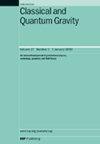Suppression of low-frequency noise using discrete component chopping noise suppression circuit for space inertial sensor drive voltage amplifier
IF 3.7
3区 物理与天体物理
Q2 ASTRONOMY & ASTROPHYSICS
引用次数: 0
Abstract
The space inertial sensor represents a pivotal component of the space gravitational wave detection apparatus, whereas the test mass (TM) it contains serves as a pivotal reference for space gravitational wave detection. The actuation circuit maintains the TM at a fixed position within the space inertia sensor. The Drive Voltage Amplifier (DVA) of the actuation circuit introduces low-frequency noise that directly affects the accuracy of gravitational wave detection at the mHz frequency. Therefore, it is of great significance to suppress low-frequency noise in the DVA. This study analyzes the noise modeling of the DVA in the actuation circuit and points out that the low-frequency noise of the DVA is mainly 1/f noise. A set of chopping noise suppression circuits is designed to greatly suppress the noise floor of the DVA under the premise of ensuring the functionality of the circuit. Based on chopping technology, a set of chopping noise suppression circuits is designed, and a prototype circuit was constructed for experimental analysis. The test results show that the noise floor of the DVA circuit at 1 mHz had been reduced from 21.7 ± 1.51 μV √Hz−1 to 1.35 ± 0.22 μV √Hz−1, which notably diminished the noise floor of the DVA circuit and can be applied to the design of future actuation circuit for the space inertial sensor.空间惯性传感器驱动电压放大器中离散分量斩波噪声抑制电路的低频噪声抑制
空间惯性传感器是空间引力波探测装置的关键部件,其所含的测试质量是空间引力波探测的关键参考。驱动电路使TM保持在空间惯性传感器内的固定位置。驱动电路的驱动电压放大器(DVA)引入低频噪声,直接影响mHz频段引力波探测的精度。因此,抑制DVA中的低频噪声具有重要意义。本文分析了DVA在驱动电路中的噪声建模,指出DVA的低频噪声主要为1/f噪声。设计了一套斩波噪声抑制电路,在保证电路功能的前提下,极大地抑制DVA的本底噪声。基于斩波技术,设计了一套斩波噪声抑制电路,并搭建了原型电路进行实验分析。测试结果表明,DVA电路在1 mHz频段的本底噪声由21.7±1.51 μV√Hz−1降低到1.35±0.22 μV√Hz−1,显著降低了DVA电路的本底噪声,可用于未来空间惯性传感器驱动电路的设计。
本文章由计算机程序翻译,如有差异,请以英文原文为准。
求助全文
约1分钟内获得全文
求助全文
来源期刊

Classical and Quantum Gravity
物理-天文与天体物理
CiteScore
7.00
自引率
8.60%
发文量
301
审稿时长
2-4 weeks
期刊介绍:
Classical and Quantum Gravity is an established journal for physicists, mathematicians and cosmologists in the fields of gravitation and the theory of spacetime. The journal is now the acknowledged world leader in classical relativity and all areas of quantum gravity.
 求助内容:
求助内容: 应助结果提醒方式:
应助结果提醒方式:


